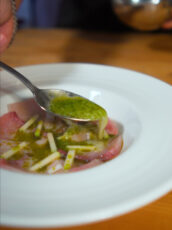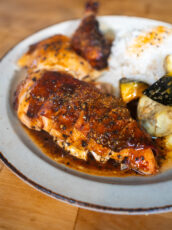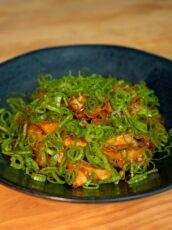Everyone should know how to make at least one great raw fish dish.
When I was working in restaurants, raw fish appetizers were always some of the most exciting dishes to create. There’s endless room to experiment with flavors, textures, and plating, and I believe it’s one of the clearest ways to show off your personal cooking style.

In this guide, I’ll walk you through:
- What every raw fish dish needs to be great
- How to select and cure fish properly for raw preparation
- A simple but professional-level Hamachi Crudo recipe you can easily recreate at home
Whether you’re new to crudo or looking to refine your technique, learning the basics of curing, balancing flavors, and thoughtful fish selection can take your raw dishes from good to unforgettable.
🥢 What Every Raw Fish Dish Should Have
There’s no single right way to prepare crudo, sashimi, or tartare — but in my opinion, every great raw fish dish should have these five key elements:
- Acid: To brighten and balance (like citrus juice or vinegars)
- Fat: To add richness and round out flavors (like oils, coconut milk, or avocado)
- Freshness: A crisp bite or bright herb to lift the dish
- Crunch: A textural contrast for an exciting mouthfeel
- Something Special: A finishing touch that adds a little “wow” factor — think shaved cured yolk, gels, or exotic garnishes
When you hit these five points, you create a dish that feels complete, balanced, and unforgettable in just one bite.
🎣 How to Select Fish for Raw Consumption

Choosing the right fish is essential when preparing raw dishes.
- Look for “sushi-grade” or “sashimi-grade” labels.
These indicate that the fish was flash frozen at sea or at the processing facility, a necessary step to kill parasites and make it safe for raw consumption. - Fresh doesn’t always mean better.
In fact, many professional chefs intentionally age fish for raw dishes. Controlled aging enhances flavor by allowing enzymes to break proteins down into savory, umami-rich amino acids — giving the fish a deeper, more complex taste. - Consider the fat content.
- Leaner fish like snapper, hamachi or tuna loins, or sea bream can benefit from light aging to bring out natural sweetness and savoriness.
- Fattier cuts like yellowtail belly, salmon belly, or toro are best eaten fresher because high fat content can turn rancid faster.
- Leaner fish like snapper, hamachi or tuna loins, or sea bream can benefit from light aging to bring out natural sweetness and savoriness.
Selecting thoughtfully and preparing your fish properly is a game-changer for creating crudo that truly stands out.
🧂 Why and How to Cure Fish for Crudo

Curing is a simple but critical step that elevates the flavor and texture of raw fish.
A light cure:
- Firms the flesh slightly for a cleaner mouthfeel
- Enhances natural sweetness and deepens umami
- Neutralizes unwanted aromas for a fresher experience
For this Hamachi Crudo, I use a quick 2:1 salt-to-sugar cure for 30 minutes.
Quick Tips for Curing Fish:
- Even coverage: Lightly coat the entire fish surface with your cure.
- Short time: For delicate fish like hamachi, 30 minutes is ideal.
- Rinse and dry: Always rinse gently with ice-cold water and pat the fish completely dry before slicing.
A good cure ensures your raw fish tastes cleaner, feels silkier, and holds up better with the rest of your components.
🍋 Hamachi Crudo Recipe with Coconut-Lime Dressing
This Hamachi Crudo layers everything you want in a bite: acid, fat, crunch, freshness, and a special touch with cured egg yolk.
🛒 Ingredients
Fish & Garnishes:
- 200g yellowtail (hamachi, buri, or Japanese amberjack)
- 10g salt
- 5g sugar
- 5–7 Thai basil leaves
- 10–20g green apple, julienned
- 1 Thai chili, thinly sliced
- Cured egg yolk (for grating)
Coconut-Lime Dressing:
- 100g coconut milk
- 30g (2 tbsp) palm sugar, crushed
- 30g (2 tbsp) lime juice
- 1g (½ tsp) salt
- Zest of 1 lime
Rice Paper Crisp:
- Rice paper sheets
- Neutral oil (for frying)
- Salt
- Chili powder
Watercress Oil (makes extra):
- 50g watercress
- 100g neutral oil
🔪 Instructions
1. Make the Watercress Oil

- Blend the watercress and oil on low speed until coarsely chopped (20–30 seconds).
- Transfer to a pot and simmer gently over medium-low heat for 20–30 minutes until the water evaporates and the oil turns a deep green.
- Cool the oil quickly using an ice bath.
- (Optional) Let it infuse overnight before straining for a more intense flavor.
- Strain through a fine mesh sieve and store in the fridge for up to 2–3 weeks.
2. Prepare the Rice Paper Crisp
- Heat 1–2 inches of neutral oil in a skillet to 350°F (175°C).
- Fry the rice paper briefly, pressing down with tongs to keep it flat. It will puff up instantly.
- Season immediately with salt and chili powder.
3. Cure and Slice the Fish
- Remove any skin from the hamachi.
- Sprinkle salt and sugar evenly over the fish.
- Cure in the fridge for 30 minutes.
- Rinse gently in ice-cold water and pat dry completely.
- Separate the belly from the loin, and slice each section cleanly with a sharp knife.
4. Make the Coconut-Lime Dressing
- In a mortar and pestle, pound the palm sugar into the lime juice until dissolved.
- Add the coconut milk, salt, and lime zest, and stir gently.
5. Assemble the Crudo
- Lay the sliced hamachi on a plate.
- Top with julienned green apple.
- Mix 3–4 tablespoons of coconut-lime dressing with 1 tablespoon of watercress oil.
- Spoon gently over the fish without fully emulsifying the dressing.
- Place a rice paper crisp on top.

Garnish with Thai basil leaves, thinly sliced Thai chili, and finely grate cured egg yolk over everything.
✨ Final Thoughts
Mastering raw fish dishes is about more than just slicing well — it’s about knowing how to balance flavor, honor the ingredient, and elevate textures.
By learning thoughtful techniques like curing, careful fish selection, and layered component building, you can create raw appetizers that truly feel restaurant-worthy at home.
This Hamachi Crudo with Coconut-Lime Dressing is fresh, balanced, and full of small details that make a huge impact.
Happy cooking — and even happier eating.







